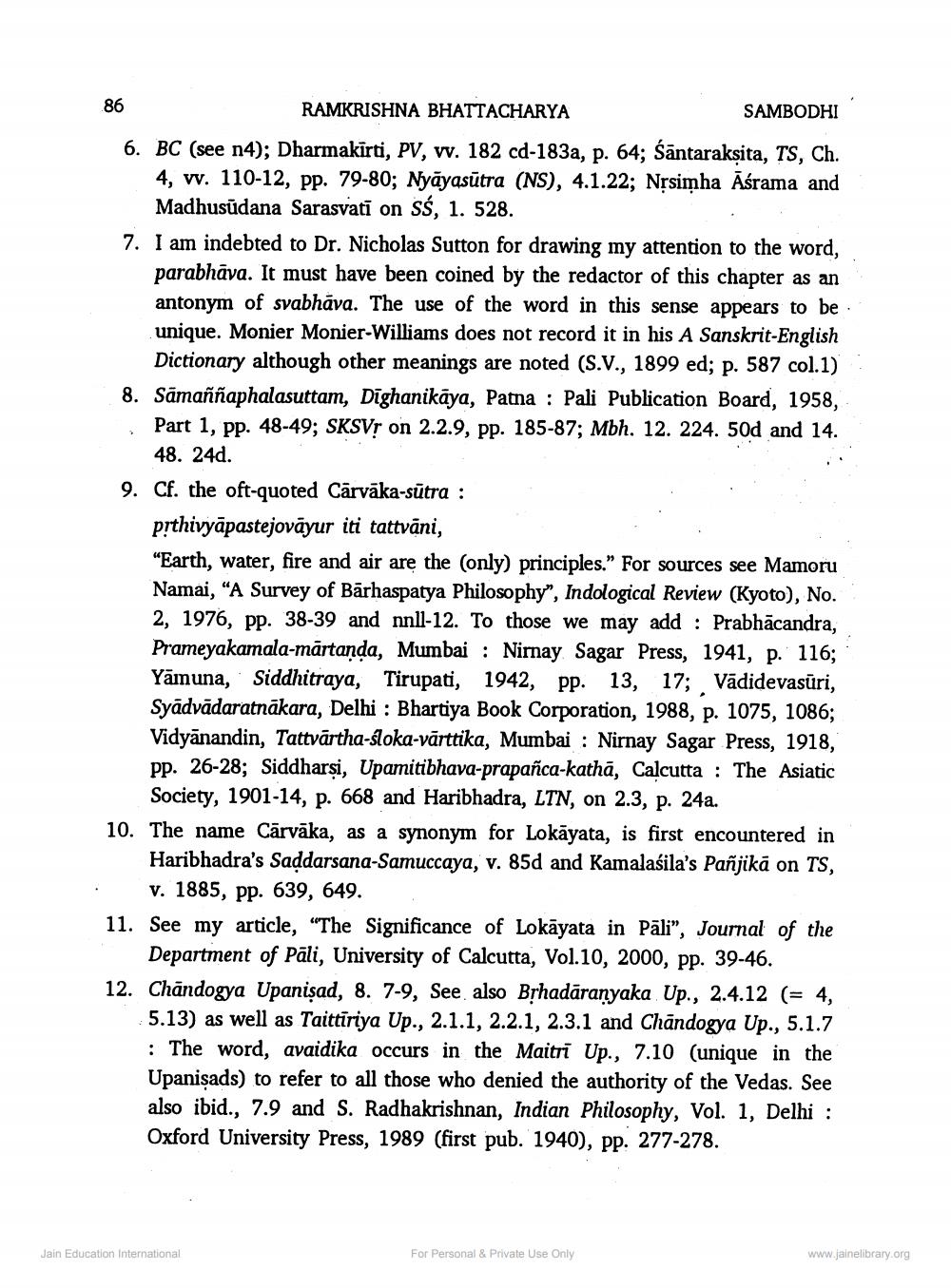________________
86
RAMKRISHNA BHATTACHARYA
SAMBODHI
6. BC (see n4); Dharmakirti, PV, vv. 182 cd-183a, p. 64; Śantarakṣita, TS, Ch. 4, vv. 110-12, pp. 79-80; Nyāyasūtra (NS), 4.1.22; Nrsimha Asrama and Madhusudana Sarasvati on SŚ, 1. 528.
7. I am indebted to Dr. Nicholas Sutton for drawing my attention to the word, parabhāva. It must have been coined by the redactor of this chapter as an antonym of svabhava. The use of the word in this sense appears to be unique. Monier Monier-Williams does not record it in his A Sanskrit-English Dictionary although other meanings are noted (S.V., 1899 ed; p. 587 col.1) 8. Samaññaphalasuttam, Dighanikaya, Patna: Pali Publication Board, 1958, Part 1, pp. 48-49; SKSVṛ on 2.2.9, pp. 185-87; Mbh. 12. 224. 50d and 14. 48. 24d.
9. Cf. the oft-quoted Carvāka-sūtra :
prthivyāpastejovayur iti tattvāni,
:
"Earth, water, fire and air are the (only) principles." For sources see Mamoru Namai, "A Survey of Barhaspatya Philosophy", Indological Review (Kyoto), No. 2, 1976, pp. 38-39 and nnll-12. To those we may add Prabhācandra, Prameyakamala-märtaṇḍa, Mumbai Nirnay Sagar Press, 1941, p. 116; Yamuna, Siddhitraya, Tirupati, 1942, pp. 13, 17;, Vādidevasūri, Syādvādaratnākara, Delhi: Bhartiya Book Corporation, 1988, p. 1075, 1086; Vidyanandin, Tattvartha-sloka-vārttika, Mumbai: Nirnay Sagar Press, 1918, pp. 26-28; Siddharsi, Upamitibhava-prapañca-katha, Calcutta: The Asiatic Society, 1901-14, p. 668 and Haribhadra, LTN, on 2.3, p. 24a.
10. The name Cārvāka, as a synonym for Lokayata, is first encountered in Haribhadra's Saddarsana-Samuccaya, v. 85d and Kamalaśila's Pañjikā on TS, v. 1885, pp. 639, 649.
11. See my article, "The Significance of Lokayata in Pāli", Journal of the Department of Pāli, University of Calcutta, Vol.10, 2000, pp. 39-46.
12. Chandogya Upanisad, 8. 7-9, See also Bṛhadaranyaka Up., 2.4.12 (= 4, 5.13) as well as Taittiriya Up., 2.1.1, 2.2.1, 2.3.1 and Chandogya Up., 5.1.7
The word, avaidika occurs in the Maitri Up., 7.10 (unique in the Upanisads) to refer to all those who denied the authority of the Vedas. See also ibid., 7.9 and S. Radhakrishnan, Indian Philosophy, Vol. 1, Delhi : Oxford University Press, 1989 (first pub. 1940), pp. 277-278.
Jain Education International
For Personal & Private Use Only
www.jainelibrary.org




